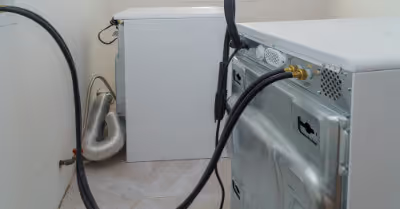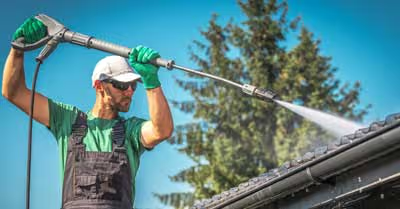Table of Contents
What are Yellow Jackets?
Most active during the summer and fall, yellow jackets are a common type of flying insects marked by a distinctive yellow and black pattern in their head and abdomen. Commonly confused by honey bees, yellow jackets are extremely aggressive, protective in nature, and will sting even at the slightest provocation.
In most cases, yellow jackets will set up their nests underground or high up in homes or residential neighborhoods and are more aggressive than honey bees and wasps. Found all over the world, there are about 16 species of yellow jackets within the United States. Given their extremely aggressive nature, having yellow jackets in or around your home can be a real pain and a dangerous situation that must be dealt with immediately and in all seriousness.
Identifying Yellow Jackets
The first important step in getting rid of yellow jackets is to identify them. Although their distinctive yellow and black patterns can make it quite easy to identify them, you should give your yard a thorough examination to find their nests. As we noted earlier, yellow jackets can have their nests either underground or perched high up somewhere within your home.
It's, therefore, important to find the number of yellow jacket nest within your home and whether there's more than one entry point into these nests. This will be essential when getting rid of the yellow jackets as you don't want a situation whereby you apply treatment from one end yet these unwanted insects escape from a different opening only to attack you.
What to Look for and Where to Inspect
If you notice a single yellow jacket flying around your home, you should follow its flight path and follow it back to its nest. You should make sure that your yard doesn't have yard debris, woodpiles, rocks or leaf litter as these are perfect places for the yellow jackets to hide their burrows and nests.
Again, keep in mind that yellow jackets can either make their nests in aerial spaces or the ground. You should, therefore, keenly observe a flying yellow jacket and see where it disappears off to. When it comes to aerial spaces, you can inspect below gutter, wall eaves, fascia boards, siding, and soffits. You can also check indoor areas such as in basements, attics, vents, crevices, in windows, and inside chimneys.
Wear Protective Clothing
Before attempting to get rid of yellow jackets, make sure that you're properly geared by dressing up for the occasion. Keep in mind that yellow jackets are very aggressive and protective and will attack you whenever you interfere with their routine. You should dress in a bee suit or in thick clothing to make sure that every part of your body is as safe as possible. In addition to protecting your body from stings, wearing protective clothing will also protect you from being overexposed to any form of chemical that you will be using.
At the very minimum, you should have the following.
- A bee suit or heavy coveralls
- High-sleeved gloves made of leather or canvas
- A securely-fitting veil, helmet, and hat
Getting Rid of Yellow Jackets
Here are a couple of ways to get rid of the unwanted insects.
Use D-Fense Dust to Treat Nests or Holes
D-Fense Dust is a deltamethrin chemical that can kill yellow jackets immediately in contact. This works perfectly in getting rid of yellow jackets that have their nests in the ground and not high up. Whether the nests are tucked away deep into the ground, under bushes or inside a wall, the D-Fense Dust can be ideal in getting rid of yellow jackets.
The D-Fense Dust will work best if you apply it in the nest using a handheld pesticide duster. This is not only to give you precision and accuracy but also to get the chemical exactly where you want it. You should put the chemical on the duster at a rate of 2 to 3 grams per square yard before squeezing the duster lightly into the duster and directly onto the yellow jackets.
Use Wasp Freeze
A wasp freeze is an aerosol spray that can quickly kill the yellow jackets in their nests. This spray has a spectacular 20-foot reach, which makes it perfect for spraying yellow jacket nests that are perched high up.
As we noted earlier, the best time to carry out this procedure is at night when you're sure that the yellow jackets are inside and less active. Wasp freeze is generally ready to use and all you have to do is shake, point, and spray directly at the nest's entry points for about 10 seconds. You should drench the entire nest to increase your chances of killing all the yellow jackets. Keep in mind that wasp freeze can be poisonous to both humans and pets and so you shouldn't let anyone or anything near that area for the next 5 hours.
Use Sylo Insecticide
Using a sylo insecticide will only be successful if you want to get rid of yellow jackets in a large area. The best thing to do is to measure and multiply the area in length and width and apply the insecticide at a rate of 1.3 oz. to 5.1 oz. of the insecticide to water. Spray every part of the nest and do not let people or pets near those areas in the next 5 hours.
Set up Solar-Powered Jar Traps
Get an outdoor jar trap and place it at the entry point of the yellow jackets nest. You should pour a sugary solution inside the jar to attract the insects into the solar-powered jar. Once the yellow jackets enter the jar, they'll either die through getting dehydrated by the heat inside the jar or by drowning inside the sugary solution.
Place Dry Ice Into The Nests
This can work best when the yellow jacket nests are on the ground. You can place dry ice into the nests and cover the entire place so that the yellow jackets cannot escape and to prevent oxygen from entering the nests. The dry ice will release carbon dioxide that will suffocate the yellow jackets to death.
Use a Vacuum to Suck them in
You can fill a vacuum with soapy water and place the head of the vacuum head at the entrance of the nest. You should then leave the vacuum there for a couple of hours to kill as many yellow jackets as possible. Do not forget that yellow jackets are very violent and it's best to do this at night when they are less active.
Use Mint Oil
Mint oil is generally deadly to yellow jackets and can be a perfect way to get rid of them. You should mix a bottle of mint oil with hot water in a spray bottle and spray the nests until they're completely drenched.
Trap the Yellow Jackets
Trapping the yellow jackets can be an ideal option when you cannot locate their nests. Given that yellow jackets prefer sugary foods, you can mix sugary stuff in a jar to entice the yellow jackets into the jar. The jar should have an inverted top and have water at the bottom so that the insects can fall into the water and drown.
You can also use a tripod of sticks with a hook dangling from the center to trap the yellow jackets. You can consider adding a piece of raw fish to attract yellow jackets, especially in spring or early summer when they're looking for a source of protein to develop their colonies.
Conclusion
Dealing with yellow jackets can be a very tricky situation. These insects are very scary given their violent nature and will sting severally to protect their nests. Having them in your home can be a very dangerous situation that cannot be taken lightly. As such, it's important to get rid of them as soon as you spot them. Make sure that you wear protective clothing to prevent them from stinging you.
Recent Articles
















